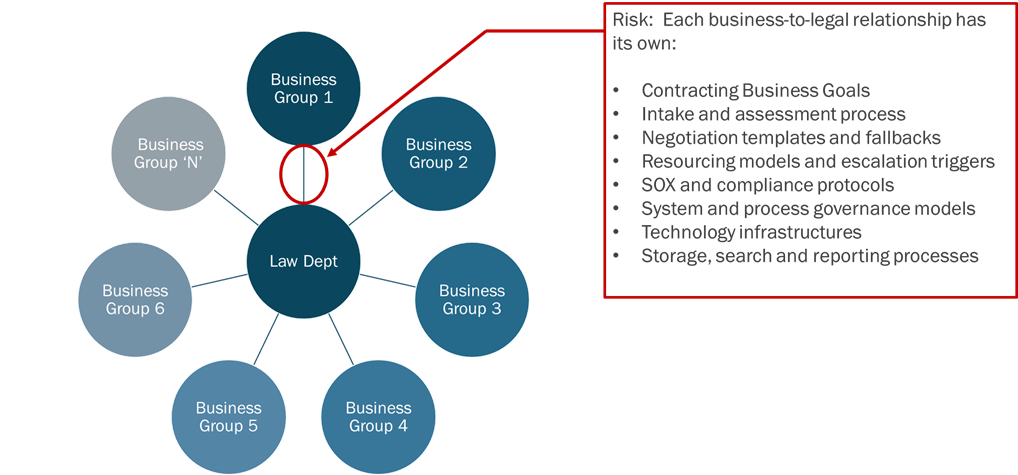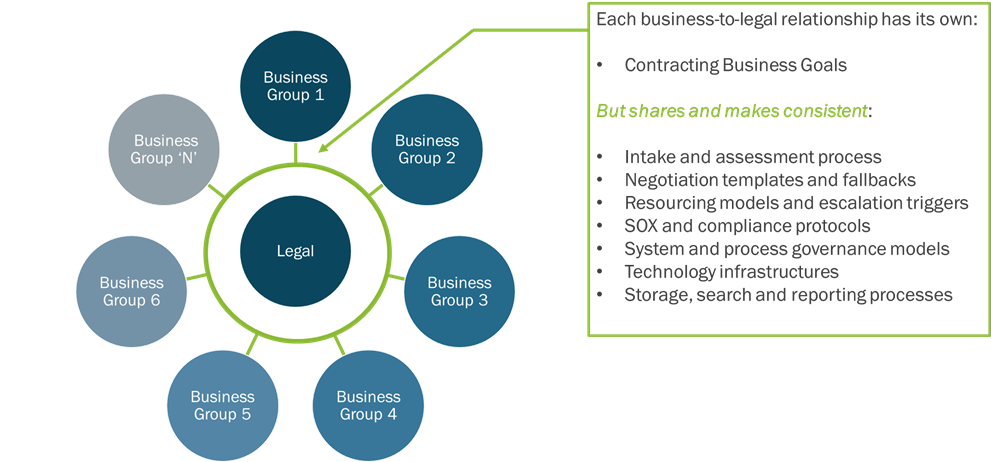For most businesses, managing transactions consistently throughout the company is a substantial challenge. Each part of the business seems to practice its own approach to its relationship with the law department, then lean into its own definition of which entity is responsible for what in the third-party relationship process. Such inconsistencies not only beg the question -- who owns your contract? -- but they also impose a tremendous drag on the company -- particularly the law department -- which must create and manage a different process for each internal client. Such a mishmash of approaches, not to mention clients, also creates contracts-related risks, such as those from company-wide events or emergent uncertainties that require rapid analysis and response.
And the solution? Is today’s approach working anymore?
First, consider the diagram below showing the current approach to company-wide transactions at many – perhaps most -- companies:


This sort of approach is not by design. It develops organically according to various factors. In our experience working with law departments, we and our Elevate colleagues frequently see several reasons for the existence of these sorts of disjointed approaches:
- Each legacy organization within the business has its own processes and evolves them at its own pace.
- In acquisitions, the acquired entity gets “tacked on” to an existing approach instead of fully integrated into it.
- The law department’s organization is fragmented, with different portions of it tied to individual business or revenue lines rather than being centralized by area of law
- The assumption that different businesses have unique requirements governs the approach to the issues of regionalization versus centralization
Many companies accept this status quo as immutable (“just the way things are”) or rationalize it (“we’ve always done things this way”). But things don’t have to remain jumbled, nor should they.
Transactions are the lifeblood of a business. They dictate revenue, legal obligations, compliance requirements, supply chain, and nearly everything else. They interconnect every part of a business. Just as human health depends on the condition of an individual’s heart (to and from which all blood flows), a business’s health. – i.e., its success at operating profitably, legally, safely, and efficiently – depends on a centralized, comprehensive, and consistent operations structure for how the business does business – that is, transactions – with customers and suppliers.
But where within a company should this entity sit? Mary O’Carroll, Chief Community Officer at Ironclad and a legal operations industry pioneer, addressed this exact question in the article “Why GCs Should Take Over Contracting”.1
We at Elevate agree with Mary about many things, including her view that the status quo is inadequate. However, our teams take her concept one step further in that we propose companies install a Central Transactions Office (CTO), headed by a Chief Transactions Officer (CTO), to operate as a centralized team charged with helping throughout the entire business rather than a subpart of it. Organizationally and operationally, the CTO doesn’t sit solely with the law department or elsewhere within the business but bridges both. In contrast to the diagram above, the CTO looks and operates more like this:

In our model, the responsibilities of the CTO (both the leader and the office) include developing, governing, and rolling out:
- a central manner and workflow in which the business requests contracts and the legal or contract management teams (or both) assess and respond to them;
- standard forms and templates for defining company contract templates and negotiation playbooks; a consistent framework for contracts resourcing, including an ARCI model for who does what and when. ARCI sets different levels of participation for people participating in a project -- A accountable, R responsible, C consulted, and I informed.
- a lean and standard set of technologies that meets the spectrum of contracting needs across all groups;
- a central repository and process for storing all agreements across the company in an easily searchable and reportable manner, including controls for compliance; and
- a mechanism that collects and centralizes contracts-related information and makes that information readily available to all for reporting/analytics.
We know our audiences like to get specific (especially when we recommend a different approach), so let’s go there.
Here is a detailed framework for establishing and enforcing the Central Transactions Office (CTO)* governance model across a company:
|
Decision Area
|
Business Function
|
CTO
|
Legal
|
IT
|
|
Defining End-to-End Business Contracting Process
|
A, R
|
R
|
R, C
|
I
|
|
Establishing / Governing Templates
|
C
|
R
|
A, C
|
I
|
|
Training Business On Templates and Process
|
A, R
|
R
|
C
|
I
|
|
Establishing Legal and Commercial Negotiation Playbooks
|
A, R
|
R
|
R, C
|
I
|
|
Setting Approval Authorities
|
C
|
R
|
A, R
|
I
|
|
Drafting First Version of Agreement
|
A, R
|
R*
|
C
|
I
|
|
Negotiating Agreement
|
A, R
|
R*
|
R, C
|
I
|
|
Executing Agreement
|
R
|
R*
|
R
|
I
|
|
Storing Agreement
|
I
|
A, R
|
I
|
I
|
|
Extracting / Managing Obligations
|
A, R
|
R*
|
I
|
I
|
|
Maintaining and Documenting Contract Process and Knowledge Base
|
C
|
R
|
C
|
I
|
|
Automating Processes
|
R
|
A, R
|
C
|
R, C
|
|
Reporting / Analytics
|
R, I
|
A, R
|
R, I
|
C
|
- The CTO can enable itself to be centrally responsible (“R”) for these items by implementing cost-effective shared service teams and outsourcing. See related article.2
Note that all parts of the business (including legal) should support and fund the office without any of them being responsible or accountable for the office. Instead, like any other corporate function and office (finance, marketing, HR, etc.), the CTO would have an independent leader who reports to the company’s top leadership and runs the office to serve the entire company by supporting transactions processes and reporting.
In our model, the CTO (both the officer and the office) operates in a neutral, non-partisan manner that benefits all users alike and serves as a trusted partner and resource for business client leaders in transactions and operations to enable those leaders to sharpen their focus on executing their roles and leveraging their expertise.
Interested in further reading? Deep dive with the WorldCC and KPMG 2021 Report: Can the Contracting Process Improve Without an Owner
END NOTES
- “Why GCs Should Take Over Contracting,” Mary O’Carroll, LinkedIn, November 24, 2023.
- Services: Managed Contracts (web page), Elevate.Law, January 23, 2024.
ABOUT THE AUTHORS
Pratik Patel
As Vice President of Innovation at Elevate, Pratik focuses on developing cross-solution innovations that enable customers to transform their legal resourcing, spend, and use of technology. Previously a founding member and partner at RFx LEGAL Analytics, acquired by Elevate in 2012, Pratik is well-versed in the issues involved in legal spend management, analytics, sourcing intelligence solutions, and the appropriate use of technology to achieve process efficiency. Pratik serves as faculty for the College of Law Practice Management and in 2015 was recognized as ILTA’s Most Innovative Legal Consultant. Pratik holds a Bachelor of Business Administration in finance from the University of Texas at Austin.
Ryan Sawyer
As US Geo Head and Managing Director, CLM at Elevate, Ryan is accountable for delivering strategic and operational leadership in creating “raving fans” through customer success and product implementation functions. In addition to his role leading Elevate’s CLM organization, Ryan leads US Geography Support, focusing on initiatives to help Elevate achieve best-in-class service and promote a safe and satisfied workforce. Ryan has over 15 years of experience working globally in customer-focused solutions, contract negotiation, and change management. Before joining Elevate in 2018, Ryan spent eight years creating and deploying strategic alliances in the renewable energy industry and has experience in technical and customer-focused roles in aerospace and government. Ryan is a U.S. military veteran.
Return